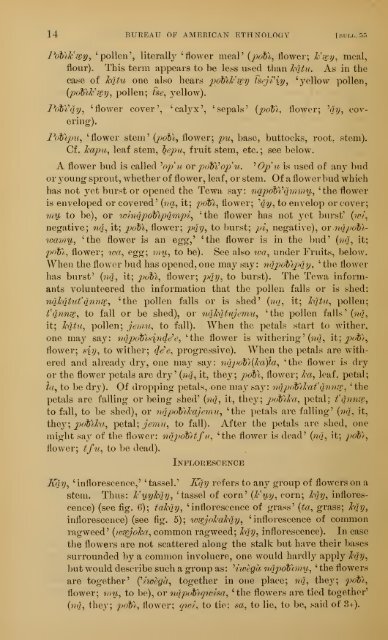Untitled - Smithsonian Institution
Untitled - Smithsonian Institution
Untitled - Smithsonian Institution
You also want an ePaper? Increase the reach of your titles
YUMPU automatically turns print PDFs into web optimized ePapers that Google loves.
14 BUREAU OF AMERICAN ETHNOLOGY [bull. 55<br />
FdbWxy, 'pollen', literally 'flower meal' (pcM, flower; Fsetj^ meal,<br />
flour). This term appears to be less used than kqtu. As in the<br />
case of kq.tu one also hears poilk^sey tseji''iy, 'yellow pollen,<br />
{pdbWs^y, pollen; fse^ yellow).<br />
PoWqoj, 'flower cover', 'cal^^x', 'sepals' (potl, flower; \Jy, cov-<br />
ering).<br />
Poiljju, 'flower stem' (poll, flower; pu, base, buttocks, root. stem).<br />
Cf . kapu, leaf stem, hepu, fruit stem, etc. ; see below.<br />
A flower bud is called ^op'u or pdbVop\i.<br />
''<br />
Op'^u is used of any bud<br />
or young sprout, whether of flower, leaf, or stem. Of a flower bud which<br />
has not yet burst or opened the Tewa say: nqpoWammy,, 'the flower<br />
is enveloped or covered' {na^ it; pdbl, flower; 'rf^, to envelop or cover;<br />
my, to be), or whiqpdbvpq/mpi^ 'the flower has not yet burst' (?^'/,<br />
negative; w^, it; pdb\ flower; pqy^ to burst; pi, negative), or nqpoilwamu,<br />
'the flower is an Qgg^'' 'the flower is in the bud' (/^r/, it;<br />
poU^i, flower; uht, ^gg; 'li'ty, to be). See also loa, under Fruits, below.<br />
When the flower bud has opened, one may say: nqpoVij>(iy, 'the flower<br />
has burst' (M, it; ^^oS^, flower; p)iV-> to burst). The Tewa inform-<br />
ants volunteered the information that the pollen falls or is shed:<br />
nqkqtufannse, 'the pollen falls or is shed' {nq, it; kqtu, pollen;<br />
fanns£; to fall or be shed), or nqkqtujeinu, 'the pollen falls' {nq,<br />
it; kqtu, pollen; jeinu, to fall). When the petals start to wither,<br />
one ma}'^ sa}'^: nqpoil.sinde'e, 'the flower is withering' (?wl, it; pot),<br />
flower; siy, to wither; de'e, progressive). When the petals are withered<br />
and already dry, one ma}" say: 7iqpotl{ka)ta, 'the flower is dry<br />
or the flower petals are dry' {nq, it, they; poil, flower; ka, leaf, petal;<br />
ia, to be dry). Of dropping petals, one may sa}^: ixjpfjbll-afqmise, ' the<br />
petals are falling or being shed' {nq, it, they; pcMhi, petal; t'qnnse,<br />
to fall, to be shed), or nqprMiJmjemu, 'the petals are falling' {nq, it,<br />
the}^; pciblTca, petal; jemu, to fall). After the petals are shed, one<br />
might say of the flower: nqpdb)tfu, 'the flower is dead' {nq, it; pdb^i,<br />
flower; tfu, to be dead).<br />
Inflorescence<br />
Kay, 'inflorescence,' 'tassel.' Kqy refers to any group of flowers on a<br />
stem. Thus: Fuyhly, 'tassel of corn' {¥y,y, corn; hqy, inflores-<br />
cence) (see fig. 6); tahqy, 'inflorescence of grass' (z!«, grass; hqy,<br />
inflorescence) (see fig. 5); wsejoluMy, 'inflorescence of common<br />
ragweed' {losejoha, common ragweed; My, inflorescence). In case<br />
the flowers are not scattered along the stalk but have their bases<br />
surrounded by a common involucre, one would hardly apply My,<br />
but would describe such a group as: Hwega nqpdbintu, ' the flowers<br />
are together' {^iwega, together in one place; nd, they; pcM,<br />
flower; my,, to be), or nqpoHqwisa, 'the flowers are tied together'<br />
{nq, they; pob), flower; qwi, to tie; sa, to lie, to be, said of 3+).

















